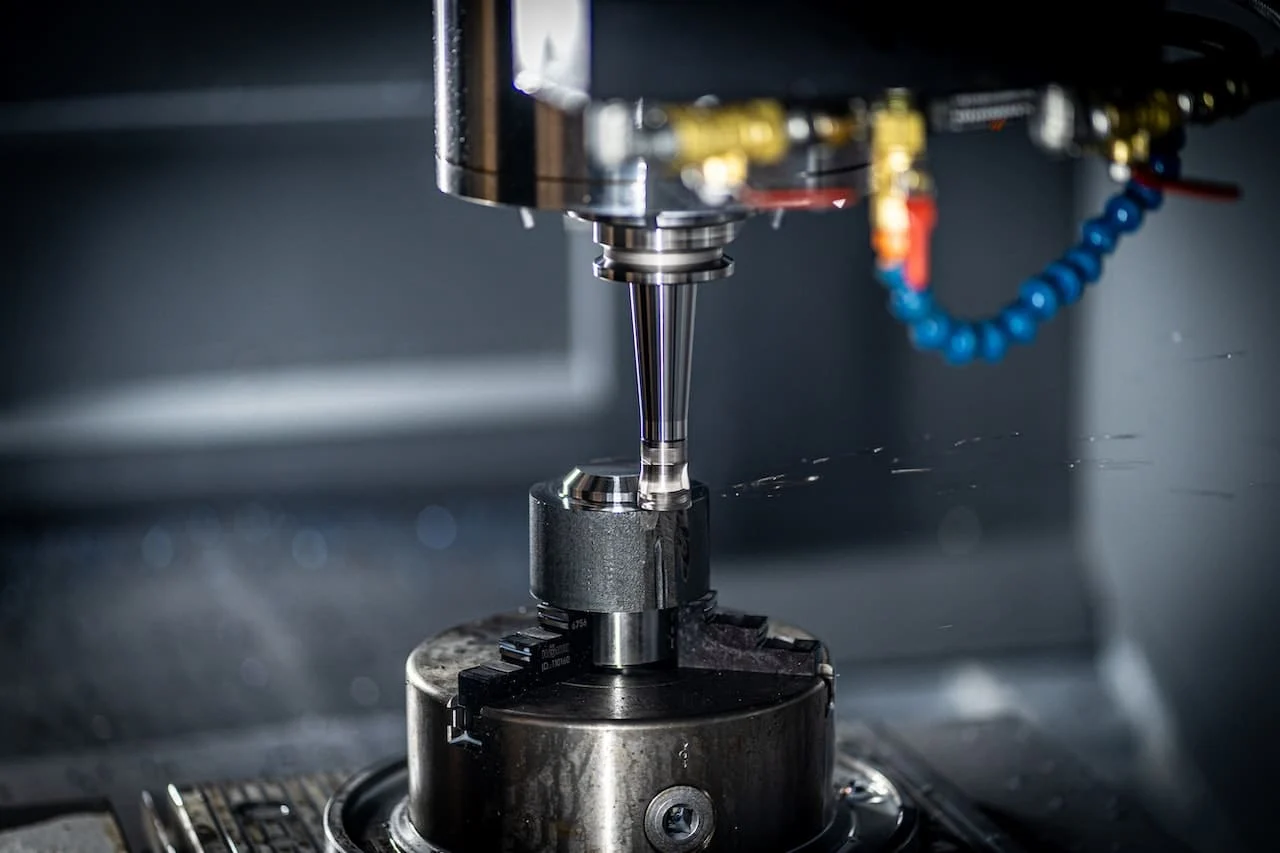TECHNOLOGY
How to Improve Manufacturing Efficiency with CNC Milling

CNC milling is an effective solution for increasing manufacturing efficiency, lowering costs, and enhancing product quality. Businesses can maximize the benefits of CNC technology by employing techniques such as process optimization, proper tool selection, regular maintenance, and complete operator training. CNC milling’s precision, speed, and flexibility allow producers to remain competitive in today’s fast-paced industry, meeting changing consumer needs while controlling production costs.
The Benefits of Industrial CNC Milling
1. Increased Accuracy and Precision
CNC machines are well-known for their ability to produce parts with high accuracy and precision, particularly when dealing with complex geometries. This eliminates the need for time-consuming manual finishing processes, reducing material waste and improving product consistency. High-precision components are critical in industries that need precise tolerances, such as aerospace, automotive, and medical device manufacturing. Industrial CNC milling‘s precision allows producers to meet or surpass customer expectations.
2. Enhanced Efficiency and Productivity
CNC milling relies largely on automation. Businesses that automate their machining processes can significantly increase production speed while maintaining consistent quality. CNC machines can operate around the clock, helping businesses to execute large orders or meet tight deadlines with minimal human intervention. This ability to raise production while retaining quality boosts overall productivity, which is especially beneficial in industries that require mass production. CNC milling reduces human error by eliminating the need for manual labor, which leads to a more efficient manufacturing process.
3. Improved Flexibility and Adaptability
One of the most intriguing features of CNC milling is its adaptability. CNC machines can be easily programmed to produce a wide range of things with varying levels of complexity. This versatility enables producers to respond quickly to changing market demands or consumer preferences without investing heavily in new equipment. The ability to quickly switch between goods provides enterprises with a competitive advantage, allowing them to meet various client demands and explore new market opportunities. CNC milling offers unequaled adaptability, whether producing small batches of unique parts or large production runs.
4. Reduced Costs
Although the initial investment in CNC machinery may appear pricey, the long-term benefits far outweigh the initial costs. CNC milling saves money in the long term because it increases manufacturing efficiency, reduces waste, and eliminates flaws. Automation reduces labor costs by requiring fewer personnel and technicians to monitor the equipment. Furthermore, CNC milling’s quality and consistency result in fewer rejected parts and rework, which reduces overall manufacturing costs. Businesses should expect a significant long-term return on investment by cutting direct and indirect production costs.
5. Improved Quality Control
CNC machines provide more control over the milling process, which reduces the risk of human error. This increased control ensures that every part is made to exact specifications, resulting in consistent product quality. This level of consistency is extremely significant in industries that rely on product reliability, such as medical equipment and aerospace components. CNC milling helps firms maintain high levels of customer satisfaction by reducing the number of errors and rework. It also reduces the likelihood of expensive recalls and warranty claims.
Strategies for Optimizing CNC Milling Efficiency
While CNC milling has many benefits, the key to attaining its full potential is optimization. Here are some methods that businesses can utilize to improve CNC milling efficiency:
1. Process Optimization
The first step in increasing CNC milling efficiency is to conduct a thorough analysis of existing manufacturing processes. This study should identify where CNC milling can be most effectively applied. When making a decision, it is important to consider part complexity, manufacturing volume, and tolerance needs. Streamlining the production workflow, identifying bottlenecks, and applying CNC technology where it is most effective will significantly boost productivity.
2. Fixture Design
Investing in high-quality fixtures is essential for keeping parts secure and precise during the milling process. Proper fixture design reduces setup time and improves machining accuracy by reducing movement or shifting when cutting. Well-designed fixtures enable repeatable procedures, which are essential in bulk production or when producing precision parts. Fixture design innovations that decrease the need for manual changes can lead to faster production cycles and more reliable results.
3. Tool Selection
Choosing the appropriate cutting equipment for the job is another important aspect of enhancing CNC milling efficiency. The material type, cutting speed, depth of cut, and part-specific machining needs should all be considered while selecting a tool. High-quality tools not only increase machining efficiency but also endure longer, resulting in fewer tool changes and downtime.
4. Programming Efficiency
CNC programming has a major impact on machining performance. Advanced Computer-Aided Manufacturing (CAM) software can improve CNC programs by enhancing toolpath efficiency, reducing cycle times, and eliminating unnecessary machine movements. Efficient programming ensures that CNC machines operate at full capacity, reducing idle time and allowing for faster production runs. Manufacturers can optimize CNC programs to achieve smoother operations, decreased energy consumption, and increased productivity.
5. Maintenance and Calibration
Regular maintenance and calibration are essential to keep CNC machines running at peak performance. This includes cleaning, lubrication, wear and tear examination, and ensuring that all machine components are properly aligned. Neglecting equipment maintenance can lead to problems, poor accuracy, and costly downtime. Implementing a preventative maintenance approach reduces unexpected repairs, extends equipment life, and ensures consistent output quality over time.
6. Operator Training
Even with the most advanced CNC machines and software, the operator’s skill level is critical to the success of any production process. Comprehensive training for CNC operators ensures that they learn how to operate the machines effectively. Skilled operators can optimize settings, resolve issues, and ensure seamless functioning.
A Manufacturer’s Success with CNC Milling
Consider the case of a major vehicle component manufacturer to demonstrate the actual application of CNC milling. Faced with increased demand and tight deadlines, the company sought to improve its production process while maintaining high product quality. By introducing industrial CNC milling machines into their production line, the company realized three significant improvements:
- Increased Production Speed: By automating milling processes, the company was able to significantly reduce production time, allowing them to meet tight deadlines while preserving quality.
- Reduced Labor Costs: CNC milling removed the need for manual labor, allowing the company to reallocate employees to other productive tasks.
- Improved Product Quality: The precision of CNC milling resulted in fewer faults, reducing the need for rework and improving overall product reliability.
- Cost Savings: Lower labor and material waste, combined with fewer errors, resulting in considerable long-term cost savings that offset the initial investment in CNC technology.
The manufacturer gained a competitive advantage in the vehicle market by using CNC milling, as well as enhancing efficiency.
Conclusion
Industrial CNC milling is an effective way to increase manufacturing productivity, reduce costs, and improve product quality. Businesses can optimize the benefits of CNC technology by implementing practices like as process optimization, correct tool selection, routine maintenance, and comprehensive operator training. CNC milling’s precision, speed, and flexibility enable businesses to remain competitive in today’s fast-paced market, meeting changing consumer demands while keeping production costs under control.
APPS & SOFTWARE
How To Manage Employees at Scale: Workforce Management Software

Companies that maintain a clear record of employee time, attendance, and tasks may experience boosted performance and improved bottom lines. Workforce management software enables labor-intensive organizations to maximize labor efficiency, minimize compliance risks, and develop strategic insight that improves business operations. Embracing a data-driven approach to management helps companies retain talent, cut labor costs, and adhere to labor laws. Here are a few ways workforce software can help you manage employees at scale:
Improved Labor Optimization
Management software identifies and alerts management to labor issues such as overstaffing or understaffing based on forecasted workloads. Workforce management software analyses historical data and business trends to align staff schedules with anticipated demand. It factors employee availabilities, skills, and preferences to generate optimized schedules that result in better timekeeping and adherence to deadlines. Businesses may experience reduced scheduling errors, optimized workforce utilization, smoother shift planning, and improved employee satisfaction due to fair and balanced schedules. Labor optimization increases productivity and success rates as each task is assigned and complies with the company’s workflow.
Enhanced Demand Forecasting
Accurately forecasting demand for a large and dispersed workforce, including remote employees, can present significant growth and operational efficiency opportunities. Miscalculated labor requirements lead to inefficient staffing that strains the budget and interferes with performance. A workforce management system uses artificial intelligence algorithms to predict workload volume for active operation days. The forecasted data can help management make informed decisions on when to increase or scale down the workforce. The software uses repeated data patterns to forecast future requirements, helping businesses to have better budget and resource allocation planning.
Automated Scheduling
Manual schedule creation is time-consuming for a large workforce, especially when different shifts and employee skills are involved. Workforce management systems are automated and generate schedules that align with forecasted demand, employee availability, and skill sets. Such systems allow for easy updating and making changes to the schedule. A workforce management tool features workforce sharing, smart templates, and shift swapping. It will enable staff to pick up open shifts or make changes that a supervisor approves. Automated scheduling streamlines administrative tasks and promotes equitable distribution of shifts.
Improved Time Tracking and Attendance
Employee attendance and time tracking help calculate the number of hours worked, overtime, and absences. Managing data tracking manually for a large workforce can pose challenges in terms of time consumption, error risks, and complexity. Workforce management software provides a more efficient solution by automating the time-tracking process. Employees clock in and out using their devices, eliminating discrepancies or manual calculations. This feature also helps managers better understand their employees’ productivity and identify any issues that may arise.
Improved Compliance and Reporting
Compliance with labor laws and regulations is a requirement for any organization. The laws stipulate maximum working hours, minimum wage, and overtime pay. Employees are entitled to rest, meal breaks, and a set number of vacation days. A workforce software ushers in automation and standardization, promoting law adherence. The software also generates comprehensive reports on employee data. The report makes it easier for organizations to monitor compliance and identify any areas of improvement. These reports can also aid in identifying trends and patterns within the workforce, enabling organizations to make proactive changes.
Enhanced Employee Engagement
Features in a workforce management system, including newsfeeds, polls, surveys, and scheduling communications, support effective information sharing across the organization. Highly engaged employees are more productive, have lower absenteeism rates, and stay with the company longer. Workforce management tools improve employee engagement in various ways. The software allows employees to view their schedules and adjust as needed, promoting transparency and control over their work hours. It provides a platform for employees to request time off, swap shifts with colleagues, and communicate with managers. This level of autonomy and communication fosters a sense of ownership and teamwork among employees. The software can track employee performance and provide top performers, further boosting engagement levels.
Maximize Efficiency With Workforce Management Software
Effective communication improves workplace efficiency and reduces errors. Workforce management software allows for streamlined communication between employees, managers, and HR personnel. The software sends automated notifications, reminders, and updates to keep everyone on the same page. It also provides a centralized platform for all employee information, eliminating the need for multiple manual systems. Investing in workforce software may lead to significant cost savings and improve organizational success. Implement workforce software into your business processes today.
GADGETS
Choosing the Right Driveway Bollards for Your Home: Factors to Consider

In every homeowner’s journey, there are selections and decisions to make that significantly impact the safety and aesthetics of the home. One such vital choice is selecting the appropriate driveway bollards. These security structures are increasingly becoming a commonplace in residential driveways. They provide safety, deter theft, enhance aesthetic appeal, and contribute to the overall value of your home.
Key Factors to Consider
Here, we are going to dig deep into several factors you need to consider getting the right driveway bollards.
1. Material
The choice of material for your driveway bollards plays a critical part in their durability, maintenance needs, and overall look. Popular materials include steel, stainless steel, aluminium, and concrete, each with its advantages and functionality.
2. Functionality
Driveway bollards can either be decorative or functional, or both. Functional bollards are usually stronger and are designed to resist vehicle impact, while decorative bollards enhance the visual appearance of your property. Consider your priorities before making a choice.
3. Design and Aesthetic Appeal
The design of your bollards ought to blend with the overall theme of your home. A mismatch could disrupt the aesthetic balance of your property. The colours, styles, and finishes are all important elements that will help ensure your bollards are in harmony with your home’s aesthetic.
4. Size and Placement
The size of your bollards and their placement determine their effectiveness in securing your property. For maximum barrier protection, ensure the bollards are placed strategically at your driveway’s entrance and exit points.
In Conclusion
Choosing the right driveway bollards requires thoughtful consideration of the aforementioned factors. Material, functionality, design, aesthetic appeal, size, and placement all are crucial elements that should be considered. It’s also worth noting that while bollards significantly enhance security, they should not interfere with the normal functionality of your driveway. A well-chosen set of bollards can be a great asset to your home, adding both practicality and aesthetic value. So take your time, do your research, consider the factors mentioned in this article, and you’re likely to come away with bollards that are fit for purpose, durable, and pleasing to the eye.
TECHNOLOGY
Best Practices for NEMT Providers: Safety, Reliability, and Compliance

In the healthcare industry, the role of non-emergency medical transportation (NEMT) services continues to become more critical.
These vital services bridge the gap between patients and their necessary medical appointments, ensuring that lack of transportation is never a barrier to healthcare access.
While availability is the heart of effective NEMT service, its foundational pillars are safety, reliability, and compliance. Each of these elements plays a crucial role in meeting and exceeding the expectations of patients and healthcare providers alike.
This article examines these ideals and how NEMT operators can effectively reinforce them in their businesses.
Ensuring Safety in NEMT Services
Safety is essential to any transportation service, especially in NEMT. Below are several ways to guarantee safety in your business.
Ensuring Vehicle Safety
NEMT vehicles must comply with safety standards and undergo regular maintenance checks to guarantee passenger safety.
This includes the mechanical integrity of the vehicles, ensuring each one is equipped to meet patients’ needs with the essential medical and accessibility equipment.
Driver Safety Training
Safety on the road transcends basic driving skills.
NEMT drivers must undergo comprehensive training covering safe driving practices, emergency response, and the unique needs of patients transported. This training should be ongoing, ensuring drivers remain at the forefront of safety and service excellence.
Patient Safety Measures
The well-being of patients during transport is a top priority.
Implementing rigorous health and hygiene protocols is essential, especially in today’s environment. Drivers must be trained in safe patient handling techniques to prevent falls and injuries and ensure patients’ secure and comfortable journeys.
Ensuring Reliability in NEMT Services
Proving to clients that you are trustworthy by delivering on your promises is crucial to the reputation and well-being of any NEMT business. Here are several ways to ensure your services are effective and reliable.
Efficient Dispatch Systems
At the center of a reliable NEMT service is a well-designed dispatch system.
Leveraging advanced software solutions enables efficient scheduling, route optimization, and real-time tracking for timely services.
Communication Protocols
Clear, open lines of communication with patients and healthcare providers form the bedrock of reliability.
This includes confirming appointments, providing updates on arrival times, and establishing a direct channel for feedback and concerns.
Contingency Planning
Unexpected events are part of the transportation world.
Having robust contingency plans in place for vehicle breakdowns, driver unavailability, or unforeseen delays ensures that the service remains reliable, even in the face of challenges.
Upholding Compliance in NEMT Services
While they may differ depending on state or region, every NEMT provider must comply with specific regulations from various entities.
Adhering to Regulations
Compliance with local, state, and federal regulations is non-negotiable.
NEMT providers must stay informed about the regulatory landscape and ensure that all aspects of their operation, from vehicle standards to driver qualifications, meet or exceed these requirements.
Medicaid Compliance
For many NEMT providers, Medicaid is a significant source of patient referrals and funding.
Navigating the complexities of Medicaid compliance, from understanding eligibility requirements to proper billing practices, is essential for operational success and integrity.
Data Security and Privacy
Protecting patient information is not just a matter of compliance; it’s a matter of trust.
Implementing stringent data security measures and ensuring compliance with HIPAA guidelines are critical in safeguarding patient privacy and securing sensitive information.
Continuous Improvement and Quality Assurance
The commitment to excellence in NEMT services is an ongoing journey.
Regular monitoring, patient feedback mechanisms, and quality assurance audits are essential in identifying improvement areas and ensuring the highest service standards are maintained.
Conclusion
Safety, reliability, and compliance are not NEMT buzzwords. These foundational principles help build successful services.
By following these best practices, NEMT providers can ensure they offer services that are needed and valued by the patients and communities they serve. In doing so, they contribute to the broader healthcare ecosystem and stand out as providers of choice in a competitive industry.

 ENTERTAINMENT4 days ago
ENTERTAINMENT4 days agoExploring the Kristen Archives: A Treasure Trove of Erotica and More

 TECHNOLOGY4 months ago
TECHNOLOGY4 months agoBlog Arcy Art: Where Architecture Meets Art

 LIFESTYLE4 months ago
LIFESTYLE4 months agoThe Disciplinary Wives Club: Spanking for Love, Not Punishment

 ENTERTAINMENT1 day ago
ENTERTAINMENT1 day agoKiss KH: The Streaming Platform Redefining Digital Engagement and Cultural Currents

 EDUCATION1 day ago
EDUCATION1 day agoLingrohub Platform: A Complete Student Access Guide

 TECHNOLOGY1 day ago
TECHNOLOGY1 day agoCasibom: The Digital Alchemy Reshaping Systems, Society, and Self

 TECHNOLOGY1 day ago
TECHNOLOGY1 day agoSecuring Your Online Presence: The Ultimate Guide to Buying an SSL Certificate

 BUSINESS1 day ago
BUSINESS1 day agoDiversifying Your Portfolio: The Key to Successful Investing in Portland, Oregon










